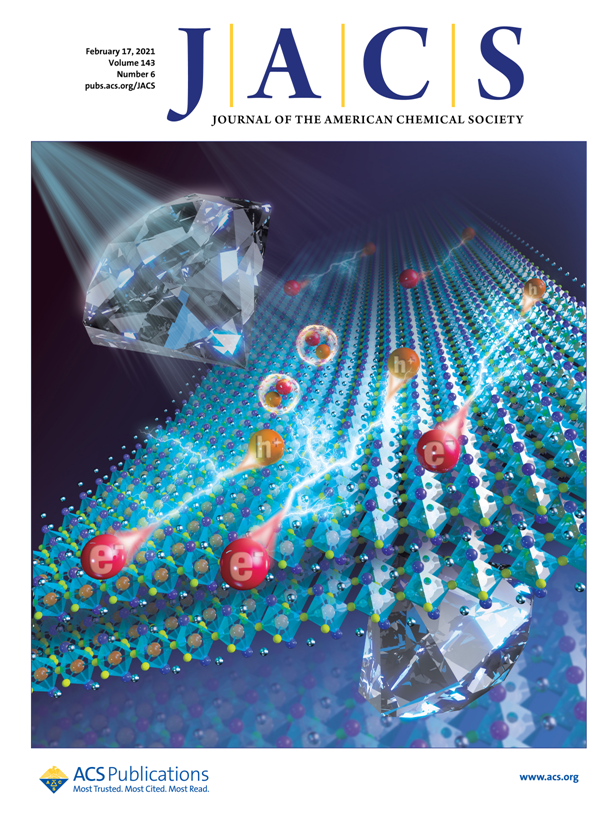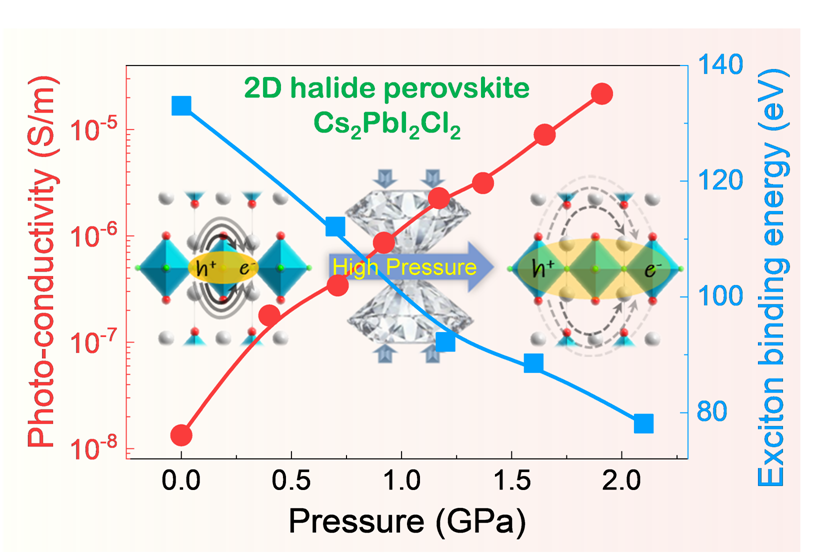Pressure-regulated excitonic features enhance optoelectronic property in 2D halide perovskites - Dr. Xujie Lü
MARCH 1, 2021
 An international team led by Dr. Xujie Lü from the Center for High Pressure Science and Technology Advanced Research (HPSTAR) discovered that lattice compression through hydrostatic pressure effectively regulates the excitonic features of an all-inorganic two-dimensional (2D) halide perovskite Cs2PbI2Cl2, reducing the exciton binding energy considerably. This behavior facilitates the dissociation of excitons into free electrons and holes, and thus enhances the photoconductivity by three orders of magnitude. The findings were recently published in the journal of J. Am. Chem. Soc. and has been selected as the cover of the issue.
An international team led by Dr. Xujie Lü from the Center for High Pressure Science and Technology Advanced Research (HPSTAR) discovered that lattice compression through hydrostatic pressure effectively regulates the excitonic features of an all-inorganic two-dimensional (2D) halide perovskite Cs2PbI2Cl2, reducing the exciton binding energy considerably. This behavior facilitates the dissociation of excitons into free electrons and holes, and thus enhances the photoconductivity by three orders of magnitude. The findings were recently published in the journal of J. Am. Chem. Soc. and has been selected as the cover of the issue.
Two-dimensional (2D) halide perovskites have recently emerged for photovoltaic and optoelectronic applications due to their unique and tunable properties. Despite substantial progress being made on the development of these materials, critical questions remain, such as how the structural regulation affects their excitonic features which govern the optoelectronic properties of 2D halide perovskites. Addressing these challenges calls for better understanding of fundamental mechanisms.
Pressure engineering has been widely used to modify the physical and chemical properties of perovskite materials and further our fundamental understanding of structure-property relationships. Therefore, studies on pressure-induced variations of structures and emission properties of 2D halide perovskites have been growing rapidly in recent years. However, no research has focused on their photo-response under high pressure despite the fact that the influence of excitonic features on their optoelectronic properties is of great importance.
In this work, the team applied pressure to tune an all-inorganic 2D perovskite Cs2PbI2Cl2, who possesses a unique excitonic feature due to the significantly smaller interlayer distance compared with hybrids. This enables to reach the unexplored structural region and provide more tuning opportunities for both fundamental studies and performance optimization.
By applying pressure, a remarkable enhancement in photoconductivity is achieved, reaching more than three orders of magnitude increase at 2 GPa in comparison with its initial value. Using in situ experimental characterization and first-principles calculations, the enhancement was demonstrated to be caused by the pressure-regulated excitonic features. The dielectric confinement is greatly suppressed during compression, providing lower shielding of the Coulombic interactions between electrons and holes. Consequently, the exciton binding energy of Cs2PbI2Cl2 decreased from 133 meV at ambient conditions to 78 meV at 2 GPa, reaching a value comparable to the typical 3D halide perovskites. Further compression induces a tetragonal-to-monoclinic phase transition that arises from the sliding of the octahedron layers. Intriguingly, an unusual negative-linear compression phenomenon was observed in the high-pressure phase ofCs2PbI2Cl2 due to the contraction of the octahedron along the sliding direction but expansion perpendicular to the sliding direction, which has never been reported in halide perovskites.

Caption: Pressure-reduced exciton binding energy and enhanced photoconductivity in 2D Cs2PbI2Cl2.
二维卤化物钙钛矿具有多样且可调的光电特性和较好的稳定性,在高效太阳能电池和发光二极管等领域具有很好的应用前景。近些年来二维钙钛矿新材料的开发已经取得了重大进展,但仍存在一些关键问题亟待解决,比如结构调控如何影响其激子(电子空穴对)特性。北京高压科学研究中心的吕旭杰研究员、杨文革研究员和美国西北大学的Kanatzidis教授等组成的国际合作团队发现,压力调控可以显著提升全无机二维钙钛矿Cs2PbI2Cl2的光电响应,当压力达到2 GPa时,其光电导增加了三个数量级。原位实验表征和第一性原理计算表明,在较低的压力下即可大幅调节Cs2PbI2Cl2的激子特征,降低其激子结合能(从常压的133meV降至2 GPa时的78meV),从而有效促进光生激子解离成自由载流子。该工作不仅首次在二维钙钛矿中实现了压力诱导的光电导增强,而且揭示了其激子特征与光电性能之间的关系。相关成果以“Enhanced Photocurrent of All-Inorganic Two-Dimensional PerovskiteCs2PbI2Cl2 via Pressure-Regulated Excitonic Features”为题,发表于近期的《美国化学会会志》Journal of the American Chemical Society上。
